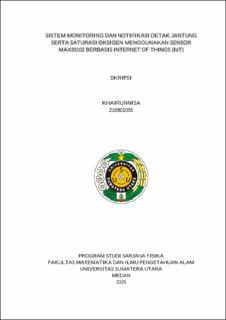Sistem Monitoring dan Notifikasi Detak Jantung Serta Saturasi Oksigen Menggunakan Sensor MAX30102 Berbasis Internet Of Things (IoT)
Heart Rate and Oxygen Saturation Monitoring and Notification System Using Max30102 Sensor Based on the Internet of Things (IoT)

Date
2025Author
Khairunnisa, Khairunnisa
Advisor(s)
Situmorang, Marhaposan
Metadata
Show full item recordAbstract
This study aims to design and evaluate the performance of a wearable Internet of Things (IoT)-based monitoring and notification system prototype. The prototype integrates an ESP32 microcontroller, a MAX30102 sensor to measure heart rate (BPM) and oxygen saturation (SpO₂), and a Ublox Neo 6M GPS module for location tracking, with data monitored in real-time via the Blynk platform. System testing results demonstrate full functionality, where the three-channel notification system (Blynk Push Notification, E-mail, and WhatsApp) was functionally tested through two main scenarios. In the “Alert” scenario, the system successfully triggered a notification when SpO₂ dropped to <95% due to engineered local hypoxia, while BPM remained stable in the normal range (60-100 BPM), proving the system’s ability to isolate triggers. In the “Emergency” scenario, an alert was accurately triggered when physical activity increased BPM to >120 BPM, even as the SpO₂ level remained stable and normal. Component accuracy testing showed the GPS module had an average error of 3.01 meters, while the MAX30102 sensor achieved 99,42% accuracy for SpO₂ and 98,24% for BPM when compared to a standard medical device. This prototype proved to be a valid and effective solution for remote health monitoring with a reliable early warning system.
Collections
- Undergraduate Theses [1379]
